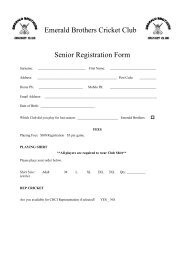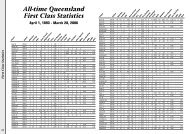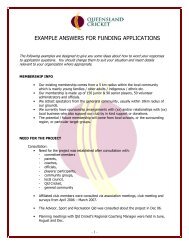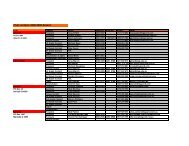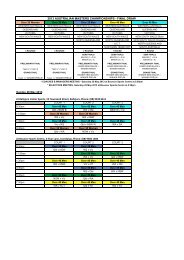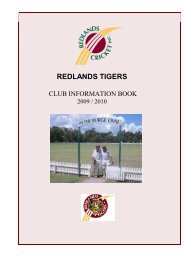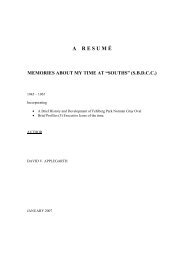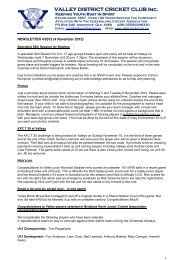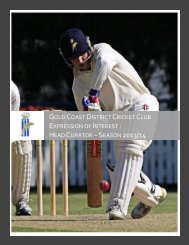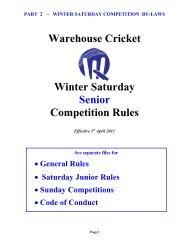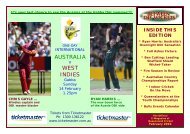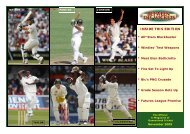the history of western suburbs district cricket club 1921-2002
the history of western suburbs district cricket club 1921-2002
the history of western suburbs district cricket club 1921-2002
You also want an ePaper? Increase the reach of your titles
YUMPU automatically turns print PDFs into web optimized ePapers that Google loves.
-36-player scored a century all season. The three years with WSDCC must have been very emotionallydraining for John Bell since he used to spend hours at Graceville after practice cajoling <strong>the</strong> best possibleperformances out <strong>of</strong> players. To some he was a fa<strong>the</strong>r, to o<strong>the</strong>rs a marriage guidance counsellor. Somehe disagreed with. His main wish was to be respected whilst not necessarily being loved as a successfulleader. John would occasionally use unusual tactics to win matches such as placing nine fieldsmenwithin three metres <strong>of</strong> <strong>the</strong> bat or placing ten fieldsmen (yes ten) on <strong>the</strong> boundary and having his bowlersbowl six overs an hour on <strong>the</strong> last day <strong>of</strong> <strong>the</strong> 1987-8 grand final, all within <strong>the</strong> rules at <strong>the</strong> time.When younger, John was an extremely talented WK who performed some very sharp stumpings as wellas diving catches from his fast bowler bullies, Rackemann and Maguire. He was an excellent hard hittingbatsman who was not averse to hitting <strong>the</strong> ball in <strong>the</strong> air with great ferocity. His favourite shots weresquare <strong>of</strong> <strong>the</strong> wicket but he was also an excellent driver. Whilst he did play two matches for Queenslandand one for Tasmania against Vivian Richards as a WK, he would not have been out <strong>of</strong> place as a statelower order batsman. John is <strong>the</strong> clear cut choice as captain <strong>of</strong> this team.Greg Rowell was invited to WSDCC by ano<strong>the</strong>r Wests player he met at <strong>the</strong> Australian Cricket Academy,Gavin Maslen. He had played a handful <strong>of</strong> matches as a promising fast bowler for NSW but sought fameand fortune north <strong>of</strong> <strong>the</strong> Tweed just as Sam Trimble had done 34 years earlier. Greg had difficulty findingGraceville Memorial Park and thought it to be deserted when he arrived and that his first practice hadbeen called <strong>of</strong>f. He did notice however some park <strong>cricket</strong>ers playing a match on a Gabba grass wicketon Graceville No 3. He wandered over to be a spectator for a while to see what <strong>the</strong> standard <strong>of</strong> park<strong>cricket</strong> was like in Queensland. When he was a little closer, he felt one <strong>of</strong> <strong>the</strong> bowlers in this match(remember he had never met any o<strong>the</strong>r Wests players before) bore a remarkable resemblance to CarlRackemann, and ano<strong>the</strong>r Dirk Tazelaar. When he saw <strong>the</strong>m bowl he felt <strong>the</strong>ir actions were very similarto those players. Finally, Greg realised this was a Wests first grade practice and unlike what he was usedto in Sydney <strong>the</strong> players wore shorts and knockabout coloured clothing. All Greg had were his longsleeved and legged whites. He quickly made his mark looking every inch a state <strong>cricket</strong>er with his bulletlike returns from <strong>the</strong> boundary (25 metres away) and terrifying <strong>the</strong> daylights out <strong>of</strong> <strong>the</strong> batsman with hisbounce on <strong>the</strong> Gabba Grass wicket.From this inauspicious introduction to Brisbane <strong>club</strong> <strong>cricket</strong>, Greg has gone on to play 37 matches forQueensland, a season with Tasmania and for Australia A in its only year in World Series Cricket. Inbetween, he had a career threatening injury when he captained second grade, nurturing not only youngplayers but renewing his own batteries just as Dennis Lillee had with a back injury in 1973-4. Indeed athis best Greg very much resembled Dennis Lillee with his movement and bounce. Apart from being aninspired leader in 2001-2 to <strong>the</strong> extent that he lifted his team into <strong>the</strong> grand final, Greg performed so wellhimself, he became <strong>the</strong> first Wests players to win <strong>the</strong> Peter Burge Medal and was again selected by <strong>the</strong>selectors to play for Queensland. He did not play but that is ano<strong>the</strong>r story. Greg himself was surprisedabout his Peter Burge medal win because <strong>of</strong> <strong>the</strong> differences <strong>of</strong> opinion he has had with umpires over <strong>the</strong>years. Perhaps Greg’s best batting moment was smashing Greg Mat<strong>the</strong>ws all over <strong>the</strong> SCG in a losingShield final.Undoubtedly Greg would have added to his 118 wickets for Queensland but for recurring foot injuries.After obtaining a primary degree at ANU, Greg recommenced study in 1999 and became a solicitor.Col Westaway was one <strong>of</strong> three <strong>cricket</strong> loving boys who grew up on a farm at Moggill. His hands wereso large <strong>the</strong>y could grip three <strong>of</strong> his beloved pineapples at once so a <strong>cricket</strong> ball was barely visible whenhe placed his fingers in <strong>the</strong> leg spinner’s position prior to giving it an enormous rip. In his 19 games forQueensland he took 52 wickets and after 1968 in his last seven seasons for <strong>the</strong> <strong>club</strong> was a very wilycustomer for a newcomer batsman to encounter. Col was by far <strong>the</strong> best spinner in <strong>the</strong> era and was <strong>the</strong>longest playing survivor <strong>of</strong> an era when Wests had three state leg spinners at once, <strong>the</strong> o<strong>the</strong>r two beingJohn Freeman and Gerry Warr. Col was also a very big hitter with <strong>the</strong> bat when <strong>the</strong> mood struck him andwas a forerunner <strong>of</strong> <strong>the</strong> modern day pinch hitter.Dirk Tazelaar came to Wests from Ipswich in 1984-5 and after taking 40 wickets at 23.40 was a fixturein <strong>the</strong> state team apart from injury until his retirement in 1995-6. He, toge<strong>the</strong>r with Carl Rackemann andthGreg Rowell (12 man) were in <strong>the</strong> first winning Queensland Sheffield Shield team in 1994-5. Dirk wasSheffield Shield Cricketer <strong>of</strong> <strong>the</strong> year in 1988-9 and went within a whisker <strong>of</strong> making <strong>the</strong> famous Ashesthtour <strong>of</strong> 1989. Indeed his 257 wickets <strong>of</strong> 27.43 in 73 Sheffield Shield matches places him 24 on <strong>the</strong> alltime interstate wicket taking list, all 23 players above him having played test <strong>cricket</strong>. Toge<strong>the</strong>r with his258 first grade wickets for Wests this made 500 wickets in first grade or first class <strong>cricket</strong>. Dirk bowledleft arm over <strong>the</strong> wicket inswingers but obtained most wickets with <strong>the</strong> away slanter or by seaming. Hisbest batting moment was late on <strong>the</strong> fourth day <strong>of</strong> a Gabba NSW match where he led Queensland to anearly season victory with some good hitting in near darkness. He suffered a bad injury during a fine legcollision with <strong>the</strong> wicket-keeper, Wade Seccombe but made a good recovery to return to play in <strong>the</strong> 1994-5 Sheffield Shield final.Peter Donaldson also was a left arm over <strong>the</strong> wicket fast bowler who made his debut against an Eaststeam containing two test players and four o<strong>the</strong>r Shield players in Round 2 <strong>of</strong> <strong>the</strong> 1971-2 season. He wenton to play 88 first grade games in nine seasons taking 282 wickets at 19.78. Toge<strong>the</strong>r with ano<strong>the</strong>r leftarmer, John Bourke, he was <strong>of</strong>ten unplayable. Peter’s finest moment was taking 6 for 25 in <strong>the</strong> SydGregory Cup for interstate colts against New South Wales. He was unfortunate never to play forQueensland. He was faster than Dirk Tazelaar, at times terrifying batsmen with his pace. Peter wenton to become amongst o<strong>the</strong>r things a sports master at BBC and has been a good talent spotter for Westsincluding boys who bear <strong>the</strong> names <strong>of</strong> famous fa<strong>the</strong>rs, Dell and Border.The twelfth man in this team is Tim Caban who came from Maitland in an attempt to break into <strong>the</strong>Queensland team at a time when <strong>the</strong> NSW team was very strong (when isn’t it if at full strength). Heachieved his aim, playing a game for Queensland in <strong>the</strong> successful 1975-6 season. Tim was a handymedium pace bowler with good control and movement and a very good hard hitting batsman. He went



